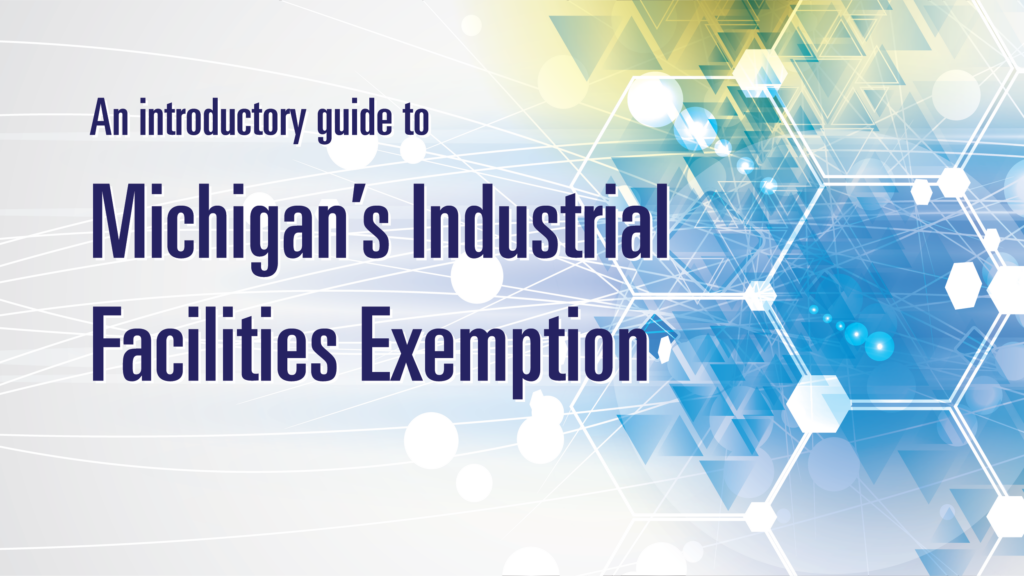
The Industrial Facilities Exemption (also known as PA 198, IFT, or Industrial Facilities Tax) remains one of the most commonly-used economic development tools in Michigan.
What is it (in two sentences or less)?
A 50 percent reduction in property taxes on new investment, for up to 12 years. It is used by local governments to help encourage investment in their communities.
How do companies qualify?
Companies that are expanding their real estate footprint, improving their current building, or investing in new equipment, machinery, or furniture may qualify. While the tool is focused on “industrial processing,” the law also allows the following types of companies to qualify:
- Advanced computing
- Advanced materials
- Biotech
- Electronic device technology
- Engineering or laboratory testing related to R&D
- Advanced vehicles technology
- Technology that assists in the assessment or prevention of threats or damage to human health or the environment
Who decides?
The local municipality where the project is located (e.g., the city, township, or village) decides whether to offer this incentive and for how long. Many communities have policies in place to determine whether to provide this incentive and for how many years (here is an ebook for communities looking to utilize PA 198). Once it is passed at the local municipal level, the State Tax Commission reviews to ensure that it fits within the statute.
What is the process?
This is a high-level outline of what is required to receive an exemption/abatement through this program. Ann Arbor SPARK has assisted dozens of companies through the process and also works with our municipal partners to help process applicants through this program. Please contact us if you’d like to learn more or apply for this incentive.
1. Establish an Industrial Development District (IDD), or confirm that one already exists on the property.
- Check and see if the parcel is in an existing IDD (the local municipality’s clerk or treasurer will know)
- If not, the company will need to request an IDD:
- Property owner (not the tenant) requests local jurisdiction to establish an Industrial Development District
- Local community processes request
- Holds public hearing
2. Application
- The application requires three parts:
- Filling out the application itself – found online: www.michigan.gov/documents/1012f_2637_7.pdf.
- Providing a legal description of the parcel(s) where the project is located. One of the easiest ways to find this is by searching for the project parcel on the municipality’s tax records. Many communities use BS&A software – find your municipality here and search by address or parcel ID: https://bsaonline.com/MunicipalDirectory.
- Providing an investment spreadsheet that includes the type of investment being made, the expected costs, and the anticipated date of installation. Real property = land improvements, buildings, structures; not the land itself.
- We recommend that the company’s accountant review the application before they submit it to the municipality for review.
- The company submits the application packet to the local municipality’s clerk’s office.
- The packet consists of two original copies of the application itself, a legal description of the parcels, an investment spreadsheet (outlined in above), and the application fee (the fee varies by community).
- Clerk processes application.
- A public hearing is set by the municipality. The date of the public hearing is shared with the company and in a local newspaper at least 14 days before the hearing.
- The company should attend the public hearing to discuss the project and answer any questions that the elected officials may have.
- If passed, the community forwards the full application to the State Tax Commission (a part of the Michigan Department of Treasury) for final approval.
3. Rules
- Must have an IDD in place before construction or purchases occur.
- The application covers a maximum of two years’ investment. Companies can “look back” six-months after investments have been made and include those in the application.
- Applications that Treasury receives from the community by October 31 will be processed before December 31.
Local example projects that have used PA 198
- KLA R&D location in Ann Arbor Township
- Toyota R&D expansion in Ann Arbor Township
- Hatch Stamping expansion in Howell Township
Where can I learn more?
- Fact sheet on PA 198 from the Michigan Economic Development Corporation
- Search previous PA 198 incentives on the Michigan Treasury website
- Best practices ebook for communities looking to utilize PA 198
Contact Phil Santer for more information on this tool.